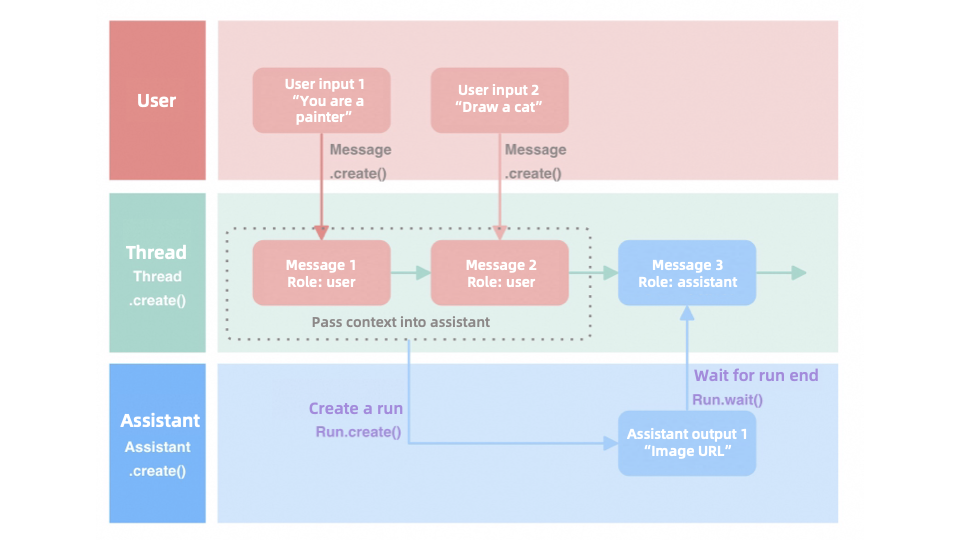The Assistant API is designed to help developers easily build intelligent chat applications, such as personal assistants, smart shopping guides, meeting assistants, and more. Compared to text generation API, the Assistant API has built in capabilities for dialogue management and tool calling, reducing development difficulty and cost.
What is an assistant
An assistant is a type of AI conversational assistant characterized by:
Support for multiple models: An assistant can be configured with various foundational models and enhanced with system instructions to tailor the personality and abilities of the model.
Tool calling: An assistant can use a variety of tools, including official tools of Model Studio such as Python code interpreter, and custom tools through function calling.
Conversation management: An assistant can manage conversations using the thread objects, which store message history and truncate it when it exceeds the context length of the model. A thread object is created once and subsequently appended with messages as the user responds.
To experience an assistant, you can simply create an agent application in the console, which does not require any programming skills. Alternatively, you can go to Get started with Assistant API for a step-by-step guide to create an assistant with the Assistant API and integrate it with your existing business code.
The agent applications created in the console differ slightly from the assistants created with the Assistant API. The agent applications can be managed exclusively in the console, while the assistants can only be managed with the Assistant API.
Differences from the text generation API
The primary element of text generation API is messages, which can be generated by models like Qwen-Plus and Qwen-Max. This lightweight API requires manual management of conversation status, tool definition, knowledge base retrieval, and code execution to build up a basic application.
On top of the text generation API, the Assistant API introduces the following core elements:
Message objects: Encapsulate the role and content of conversation information, similar to messages in the text generation API.
Assistant objects: Encapsulate a foundational model, default instructions, and tools.
Thread objects: Represent the current conversation status.
Run objects: Execute the assistant on a thread, includinging text responses and tool using.
The following sections delve into how these elements work together to create an assistant.
Interaction method
The Assistant API uses the thread mechanism to ensure messages are processed sequentially, preserving the continuity of the conversation. The process is as follows:
Create a message: Users create a message instance with the
Message.create()method, assigning it to a specific thread to maintain context association.Initialize a runtime environment: The
Run.create()function initializes the runtime environment of the assistant object, setting up the necessary configuration for message processing.Wait for the results: The
wait()function pauses execution until the assistant object completes processing and returns results, ensuring program synchronization and data sequence.
Consider a simple drawing assistant as an example:
|
Get started
If you want to test the large language models (LLMs) or get started with the Assistant API:
Playground: Test the inference capabilities of LLMs to find the most suitable one for your assistant.
Get started: The basic usage and examples of the Assistant API to help you get started with your assistant.
API references: Detailed explanations of the parameters to help you resolve development challenges.
More information
Model support
Model series | Name |
Qwen-Turbo | qwen-turbo |
Qwen-Plus | qwen-plus |
Qwen-Max | qwen-max |
Qwen2-57B-A14B-Instruct | qwen2-57b-a14b-instruct |
Qwen2-72B-Instruct | qwen2-72b-instruct |
For model compatibility with the Assistant API, refer to the actual execution results. For more information about the models, see List of models.
Tool support
Tool | Identifier | Description |
Python code interpreter | code_interpreter | Facilitates the execution of Python code, ideal for programming tasks, mathematics, and data analysis. |
Image generation | text_to_image | Transforms textual descriptions into visual images, diversifying response formats. |
Custom plug-in | ${plugin_id} | Enables integration with custom business interfaces to extend AI functionalities. |
Function calling | function | Executes designated functions on on-premises devices, independent of external network services. |
For plug-in compatibility with the Assistant API, refer to the actual execution results. For more information about the plug-ins, see Plug-in.
